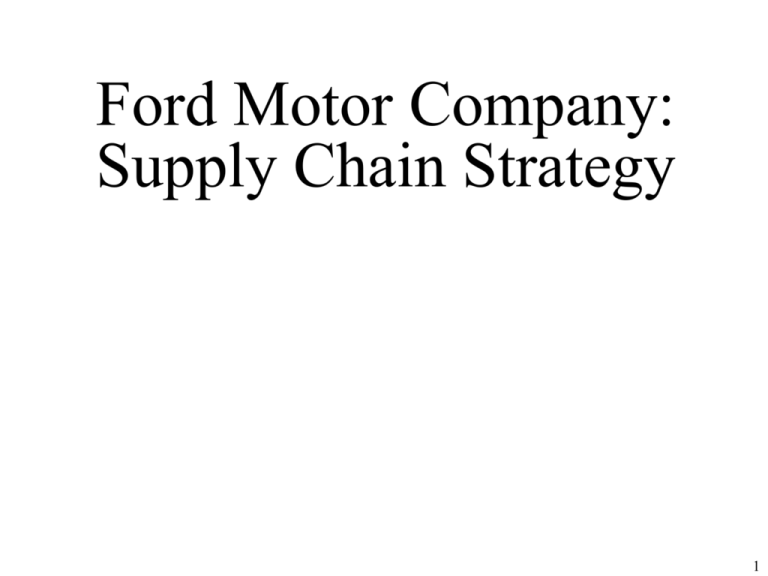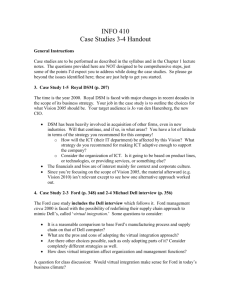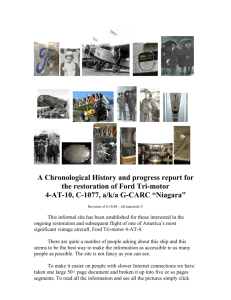ppt - Center for IT and e
advertisement

Ford Motor Company: Supply Chain Strategy 1 New Business Model • Companies like Cisco and Dell, had aggressively used technology to reduce working capital and inventory. Crucial to Ford’s future is how Ford should use emerging information technologies (e.g., Internet technologies) and ideas from new high-tech industries to change the way it interacted with suppliers. • Corporate staff members began to study Dell model. Some argued that the new IT made it inevitable entirely new business models would prevail, and that ford needed radically redesign its supply chain or risk being left behind. These group favored “virtual integration,” modeling the Ford supply chain on that of Dell. • Another group believed that the differences between the auto business and Dell were important and substantive. It was different to determine the appropriate and feasible scope for redesign of the process. 2 Company and Industry Background • Ford was the second largest industrial corporation in the world, with revenues of more than $144 billion and about 370,000 employees. Operations spanned 200 countries. The company’s core business is the design and manufacture of automobiles for sale on the consumer market. The company was the world leader in trucks. • In 1998, Ford had amassed profits of $6.9 billion and return on sales was trending solidly upward. It had taken over the U.S. industry lead in profit per vehicle ($1,770) from Chrysler. • The auto industry had grown much more competitive over the last two decades. The industry was also facing increasing over-capacity (estimated at 20 million vehicles). Ford and the other large auto-makers were moving toward industry consolidation to take advantage of their size and global presence. 3 Ford 2000 Restructuring Plan • In 1995, ford had embarked on an ambitious restructuring plan called Ford 2000. • Ford 2000 called for dramatic cost reductions to be obtained by reengineering and globalizing corporate organizations and processes. • Major reengineering projects were initiated around major company processes, such as Ford Production System (FPS) and Order-To-Delivery (OTD), with goals such as reducing OTD time from more than 60 days to15 days. • Ford’s new global approach required that technology be employed to overcome the constraints imposed by geography in information flow. Teams on different continents needed to be able to share information and worked together as if they were in the same building. • New CEO Jac Nasser emphasized on shareholder value and customer responsiveness. 4 Internet Revolution • Ford launched a public Internet site in mid-1995; by mid1997 the number of visits to the site had reached more than 1 million per day. • A company-wide intranet was launched in mid-1996, and by January of 1997 Ford had in place a Business-ToBusiness (B2B) capability through which the intranet could be extended in a secure manner into an extranet, potentially connecting Ford with its suppliers. • Ford teamed with Chrysler and General Motors to work on the Automotive Network Exchange (ANX), which aimed to create consistency in technology standards and processes in the supplier network. 5 Ford’ Existing Supply Base • In the early 1990s, Ford had begun to actively decrease the number of suppliers and develop long-term relationships with a subset of very capable suppliers who would provide entire vehicle sub-systems. These “tier one” suppliers would manage relationships with a larger base of suppliers of components of sub-systems -- tier two and below suppliers. • While first tier suppliers had fairly well developed IT capabilities, they were not able to invest in new IT at the rate Ford could. Also, the IT maturity decreased rapidly in lower tiers of the supply chain. This supply base was different in its nature and complexity from Dell’s. • Another major difference between Dell and Ford was organizational. Ford’s purchasing organization had historically played a more prominent and independent role than Dell’s. 6 Ford Production System • Modeled roughly on the Toyota Production System, FPS was an integrated system aimed at making Ford manufacturing operations leaner, more responsive, and more efficient. • One important part of FPS was “Synchronous Material Flow” (SMF), which ford defined as “a process or system that produces a continuous flow of material and products driven by a fixed, sequenced, and leveled vehicle schedule, utilizing flexibility and lean manufacturing concepts.” • The vision was of trucks constantly in motion in continuous circuits between suppliers and Ford, feeding a process that worked like a finely tuned and smoothly running system. 7 Order To Delivery • The purpose of the OTD project was to reduce to15 days the time from a customer’s order to delivery of the finished product - a significant reduction versus the present performance of 45-65 days. • Ford’s approach to implementing and improved OTD processes relied on several elements: 1) ongoing forecasting of customer demand from dealers; 2) A minimum of 15 days of vehicles in each assembly plant’s order bank to increase manufacturing stability; 3) regional “mixed centers” that optimize schedules and deliveries of finished vehicles via rail transportation; and 4) a robust order amendment process to allow vehicles to be amended for minor color and trim variations without having submit new orders. • The OTD vision was to create a lean, flexible and predictable process that provide consumers with the right products in the right place at the right time. 8 Ford Retail Network (FRN) • One of the principles of the FRN was to buy all the Ford dealers in a local market so that the dealers were in competition against the “real” competition (i.e., GM, Toyota, Honda), rather than with each other. • The overriding goal was for the consumer to receive the highest level of treatment and to create an experience they would want to come back to again and again. • The number of showrooms would be consolidated to focus resources on creating a superior selling experience, while the number of service outlets would increase to be closer to customer population centers. • Ford expected personnel and advertising cost savings, as well as inventory efficiencies due to economies of scale and greater use of the Internet. 9 The Decision • Teri Takai, Director of Supply Chain Systems, had set aside this time on her calendar to contemplate recommendations to senior executives. • Whatever she decided, she would have to do it soon. Meetings were already scheduled with the VP of Quality and Process Leadership, and from there the recommendations would move upward, eventually to CEO Nasser. • She perused the neatly prepared documents by her staff. They included a comparison between Dell and Ford on many important dimensions (Exhibit 1) and a shift from “push” to “pull” processes (Exhibit 2). • What should she recommend to senior executives? Note that whatever she decided was extremely important to Ford’s future. 10 Traditional Model Versus Direct Model Traditional Model Suppliers Distribution Channel Manufacturer order Customer delivery Dell Model order Suppliers Customer Dell delivery 11 Enterprise Model Comparison Dell Operating Principles Customer Intimacy Ford Breakthrough Objectives / Key Initiatives Demand to Delivery ford Retail Network Demand Pull Ford Production System Order to Delivery Supply Chain Mgmt Leadership Velocity Order to Delivery Ford Product Development System Virtual Integration Fixed to Variable cost Shift Modular Assembly “Extended Enterprise” 12 Enterprise Model Comparison (continued) Customers Customers order Dealers delivery Ford Retail Network OTD Order Mgmt Sales R&D Assembly FPDS DTD Commodity Suppliers Bill of Material Outbound Logistics Component Suppliers FPS FPS CFOP Plant / Site Operations Supply Chain Leadership Inbound Logistics Suppliers 13 Exhibit 2 Moving from Push to Pull Dell Processes Ford Suppliers own inventory until it is used in production Suppliers maintain nearby ship points, delivery time 15 minutes to 1 hour External logistics supplier used to manage inbound supply chain Customers frequently steered to PCs with high availability to balance supply and demand Demand forecasting is critical -- changes are shared immediately within Dell and with supply base Demand pull throughout value chain -- “information for inventory” substitution Focused on strategic partnerships: suppliers down from 200 to 47 Complexity is low: 50 components, 8-10 key, 100 permutations 14 Exhibit 2 Moving from Push to Pull Design Marketing Process Push Design strategy Please everyone Pull Mainstream customer wants Vehicle combinations More is better Minimal Pricing strategy Budget-driven Market-driven Vehicle purchase incentives Higher Lower Manufacturing Capacity planning and Supply Schedule and build stability Dealer Network Multiple material/capacity Market-driven (no constraints, FPV/CPV+10% constraints, driven by for vehicle, +15% for program budget components Maximize production make whatever you can build Schedule from customerdriven order bank, build to schedule Dealer ordering Order based on allocations Order based on customer and capacity constraints demand Order to delivery times Inventory Longer (60+days) Shorter (15 days or less) High with low turnover Low with rapid turnover Dealership model Company controlled Independent dealerships, negotiations with company dealerships (Ford Retail Network) 15






